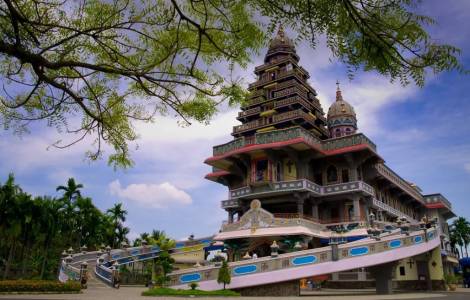ASIA/INDONESIA – Indian Jesuit Father has been living in Sumatra for 50 years: a life marked by devotion to Mary and love of God
ASIA/INDONESIA – Sumatra has seen an Indian Jesuit Father for 50 years. His life is marked by devotion and love of God.
Medan (Agenzia Fides – On Sumatra Island, an island in Indonesia inhabited mainly indigenous groups and where traditionalist Islam prevails, there is a missionary named Father James Bharataputra. He is well-known for constructing the Marian shrine “Graha Maria Annai Velangkanni”, in Medan.
Father James, an Indian father from Tamil Nadu, has been active in Medan since 1950. He is an 84 year old man. In 1989, he was naturalized as an Indonesian. Since he entered the Jesuit Order in Madurai (India), he had longed to become a missionary. After a brief stopover in Hong Kong he was sent to Yogyakarta to finish his theological studies. After his 1970 ordination, he had the opportunity of visiting Medan when the Archbishop Van den Hurk (OFMCap) asked for him to provide pastoral support to a small Tamil-speaking Catholic parish.
Father James affirms that he began pastoral work in Medan in 1972. This work continues to this day. He spent 50 years in Sumatra and also served in the province Aceh in the island’s north (then part the Archdiocese Medan). However, he was forced to leave the province after a series violence outbreaks that rocked the only Indonesian provincial that had adopted parts the “sharia” Islamic law.
Father James is the Indonesian Church’s founder, initiator, and still Rector for the Marian Shrine “Graha Maria Annai Velangkanni”, in Medan. “I am still amazed at God’s loving providence that led me to this mission country. My Jesuit superiors placed great trust in me. He says that they allowed me to serve in the Archdiocese Medan, the local Church.
The shrine was the culmination of his missionary trip. Realizing that Medan’s population lacked adequate education, he first established an educational project and rebuilt a primary school named “Karya Dharma” (“Works of Charity”) in order to provide education opportunities for children from economically disadvantaged families.
He reported that “people appreciated the initiative, and were very cooperative.”
But there were difficulties along the way. A project to promote self-sufficiency and subsistence for a Tamil community that still relies on Dutch missionaries’ charity was met with hostility by the local community. He regretted deeply that: “My vocation and my missionary life were at risk.” But the Lord saved my life,” he recalls.
Through the intercession of Mother of God, the miracle was finally achieved. “I had a vision that I could spread the devotion to Mary here, as she had shown herself in Vailankanni (Tamil Nadu) for more than three centuries. It attracted people from all walks and helped them to know her son Jesus. I realized that a shrine would bring many pilgrims from all walks to God and help them to encounter God. A shrine reminds pilgrims of their common God and helps them to remember who they are. It encourages them to love and respect each other as brothers and sisters, since they are all children from the same Heavenly Father.
The missionary had this idea in his heart and began the project to build a Marian shrine. It was supported by archdiocese. “The generosity and support of thousands of donors was remarkable. “The cost of the project (2000-2005) amounted to four billion rupees, which is about US$500,000.
Alfredo Gonti Pius Batubara, the former Archbishop to Medan, acknowledged that Father James brought his spiritual energy and work into our archdiocese. We thank him for the erection Marian Shrine Graha Maria Annai Velangkanni at Medan.
Father Ignatius Jesudasan writes that the Marian Shrine is the culmination and culmination of Father James’ missionary work in Indonesia. The architectural design is inspired by Saint Ignatius’ contemplation of the Mystery of the Incarnation in his Spiritual Exercises. As in medieval cathedrals, art is represented here by statues and paintings. The shrine has three floors: a basement floor that is used for pastoral purposes; worship and adoration are on the middle floor; and the top floor that allows for artistic contemplation and contemplation of historical-religious mystery. The shrine attracts pilgrims from all faiths and contributes to Indonesia’s religious, cultural diversity and tourism. This place has been a blessing to many. And the Indonesian Jesuit Fr. Sindhunata writes, “The shrine is where heaven and Earth meet, where God and the human embrace, and where God meets His people regardless of their ethnicity or creed.” (PA/MH) (Agenzia Fides, 25/1/2023)
Share:
Source: fides.org
